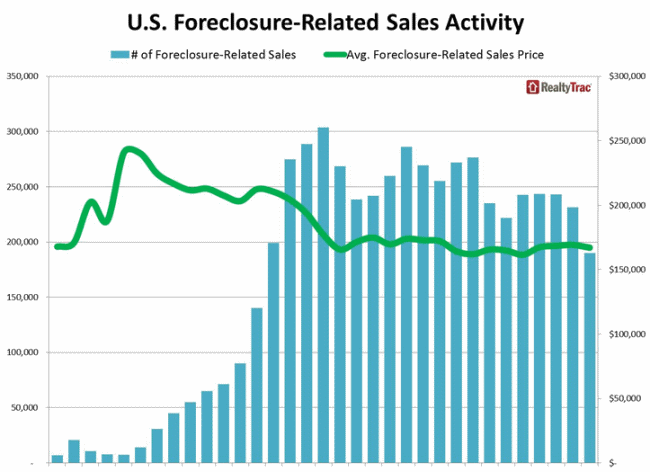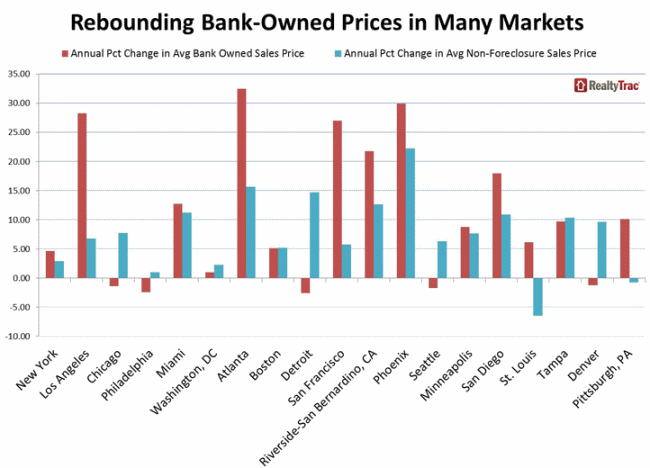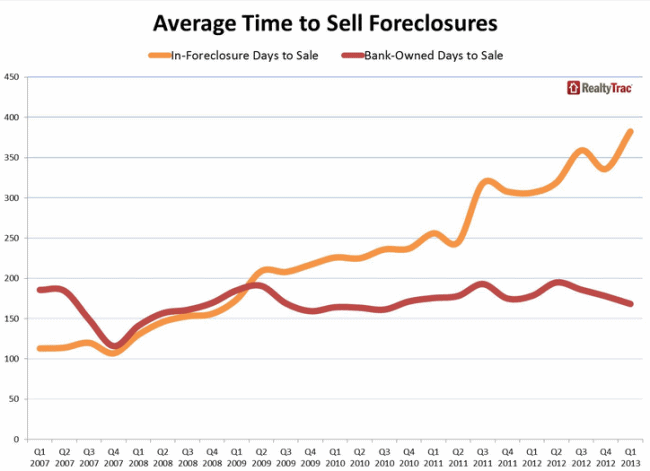Foreclosure-related home sales retreated to a 21 percent share of all homes sales in the country during the first quarter of 2013. RealtyTrac reported that a total of 190,121 houses that were bank-owned (REO) or in some stage of foreclosure sold during the quarter, down 18 percent from the number of such sales in the fourth quarter of 2012 and 22 percent lower than in the first quarter of 2012. These sales peaked in the first quarter of 2009 when they accounted for 45 percent of the home sale market.
An additional 15 percent of residential sales in the first quarter were ones in which the banks agreed to take less than the outstanding balance in satisfaction of the loan, so-called short sales, even though the property was not in foreclosure. This brought the total market share of homes that might be considered "distressed" to 35 percent in the first quarter. These non-foreclosure short sales were down 10 percent from the previous quarter and 35 percent from the same quarter in 2012.
Both types of foreclosure related sales decreased from the previous quarter and from the first quarter of 2012. Pre-foreclosure sales (typically short sales) numbered 88,750, down 20 percent from both the previous quarter and a year earlier and the lowest quarterly number of pre-foreclosure sales since the third quarter of 2009 . These sales had a 10 percent market share compared to 11 percent in the first quarter of 2012.
Third parties purchased a total of 101,371 REO properties in the first quarter of 2013, down 16 percent from the fourth quarter of 2012, 23 percent from the first quarter of 2012, and the lowest quarterly total of REO sales since the first quarter of 2008. This was an 11 percent market share, the same as in the fourth quarter but down from 13 percent of all sales a year earlier.

"We expected foreclosure-related sales to be lower given the downward trend in new foreclosure activity nationwide over the past two and a half years, but the decrease in non-foreclosure short sales was a bit of surprise given the 11 million homeowners nationwide still underwater," said Daren Blomquist, vice president at RealtyTrac. "Rising home prices in many markets are stunting the continued growth of short sales by reducing incentive for both underwater homeowners and lenders. Underwater homeowners may be willing to stick it out a few more months or even years in the hope that they will be able to walk away with money at the closing table and without a hit to their credit rating, and for lenders a failed short sale may no longer translate into bigger losses down the road given that average prices of bank-owned homes are rising - at a faster pace than non-distressed home prices in many markets."

Based on the average prices provided by RealtyTrac the prices of distressed homes do not appear to recovering as fast as home prices nationally. The average price of a foreclosure related sale was down a slight 1 percent quarter over quarter but up 3 percent from a year ago, the fourth straight quarter with an annual price increase. The consensus among national surveys, some of which exclude distressed sales from their calculations, is that home prices have risen between seven and 11 percent over the 12 months ended in March.
The average sales price of a foreclosure related home in the first quarter was $167,095. This reflected an average discount of 30 percent compared to 31 percent in the previous quarter but up from a 28 percent discount a year earlier. Short sales sold at a much higher price than REO properties, an average of $187,040 compared to $147,810. The pre-foreclosure sales price was down 1 percent from the previous quarter but was 5 percent higher than the prior year. Pre-foreclosure sales were discounted an average of 22 percent, down from 23 percent in the fourth quarter but up from 20 percent in Q1 2012.
The REO sale price was 1 percent below that of the previous quarter but 1 percent higher than a year earlier. This was the fourth consecutive quarter with an annual increase. The average price of an REO residential property in the first quarter was 38 percent below the average price of a non-foreclosure residential property, down from a 39 percent discount in the previous quarter but up from a 34 percent discount in the first quarter of 2012.
The highest level of foreclosure-related home sales were in Georgia (35 percent), Illinois (32 percent), California (30 percent), Arizona (28 percent), and Michigan (28 percent). States where foreclosure-related sales accounted for less than 10 percent of all sales include Massachusetts, New York, and New Jersey.
States with the biggest annual increases in average REO sales prices included Georgia (up 29 percent), Arizona (up 24 percent), Nevada (up 22 percent), California (up 22 percent), and Missouri (up 17 percent).
REOs that sold in the first quarter took an average of 168 days to sell after being foreclosed, down from the 178-day average from both the previous quarter and a year ago.








